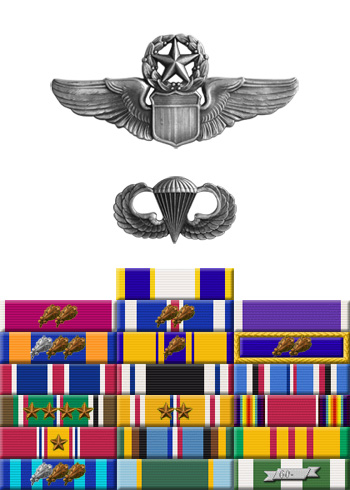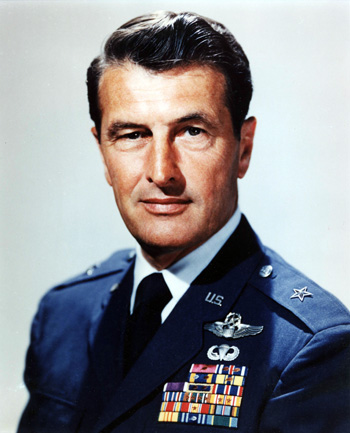
|
Frank K. Everest, Jr. |
 |
|||
| Rank, Service | ||||
Brigadier General O-7, U.S. Air Force |
||||
| Veteran of: | ||||
|
||||
| Tribute: | ||||
Frank Everest was born on August 10, 1920, in Fairmont, West Virginia. He entered the Aviation Cadet Program of the U.S. Army Air Forces on November 7, 1941, and was commissioned and awarded his pilot wings on July 3, 1942. Lt Everest flew 94 combat missions in North Africa and Italy, where he was credited with the destruction of 2 enemy aircraft in aerial combat. After an assignment as an instructor pilot in Venice, Florida, Everest was assigned to the China-Burma-India Theater where he commanded the 17th Fighter Squadron in Chinkiang, China. He flew another 67 combat missions and was credited with destroying 4 enemy aircraft while strafing Japanese airfields before being shot down by ground fire in May 1945. He was captured and held as a Prisoner of War by the Japanese until August 1945. In February 1946, Everest was assigned to the Flight Test Division at Wright-Patterson AFB, Ohio, as a test pilot. He transferred to the Air Force Flight Test Center at Edwards AFB, California, in September 1951, and took part in flight testing many of the early X-planes, as well as most of the fighters and bombers that were coming into the Air Force inventory. In March 1957, Everest was transferred to Hahn AB, West Germany, where he commanded the 461st Fighter Squadron. He was assigned as a group commander and then deputy for operations at Wheelus AB, Libya, in July 1958, followed by an assignment as director of operations of the 401st Tactical Fighter Wing at England AFB, Louisiana, in January 1961. He served as commander of several Combat Crew Training Wings during the early to mid 1960's, and he became director of aerospace safety at Norton AFB, California, in June 1966. In January 1969, Gen Everest was assigned as assistant director in the Office of the Director of Defense Research and Engineering, where he served until taking command of the Aerospace Rescue and Recovery Service at Scott AFB, Illinois, in April 1970. During the period January 1966 to September 1972, Gen Everest regularly deployed to Southeast Asia where he flew 32 total combat missions in F-4, A-1, F-100, C-130, C-141, and HC-130 aircraft. He retired from the Air Force on March 1, 1973. In 1989, Gen Everest was enshrined in the National Aviation Hall of Fame for his work as a test pilot and record setter in the 1950's. Frank Everest died on October 1, 2004. |
||||
|
||||

